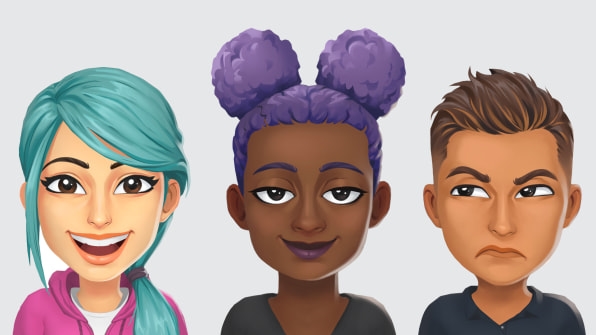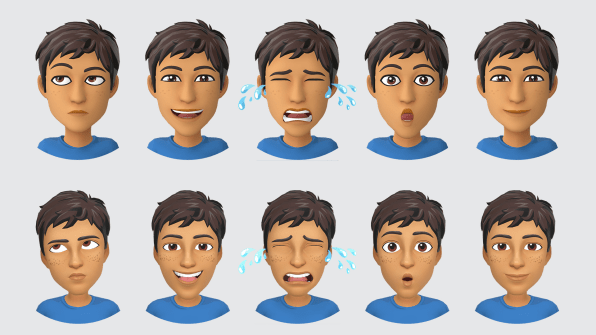Long before Apple’s memoi or Meta’s dead avatars, Bitmoji allowed people to transform themselves into cartoon alter egos and appear in comics alongside friends. After Snap acquired the company in 2016, Bitmoji went from message board meme to the official avatar of Snapchat. They serve as your profile picture. And they also appear as stickers in the feed, turning conversations into zany scenes between you and your friend group. Snapchat even has Bitmoji Stories that imagine complete animated stories that you can watch, starring yourself.
1.7 billion Bitmojis later, even as TikTok dominates social mindshare, Snap reports that 85% of Gen Zers living in the U.S. have created their own Bitmoji avatar, and 250 million people use them every day. Even as Snap continues facing challenges around revenue and selling ads, Bitmoji remain key to almost every touchpoint of its product, as it has “a profound impact on Snapchat user retention and engagement,” says Snap’s VP of product Jack Brody.
And now, Bitmojis are getting a major redesign.
Bitmojis have historically lived two lives: one as 2D cartoons, and another as static, 3D avatars that were first introduced in 2018 and later became Snap profile pictures in 2021.
Now, as part of a ground-up rebuild, Snap is starting a full transition to 3D Bitmojis that will roll out in the coming weeks. Based on new technology, the Bitmojis will now be fully animated, with more facial expressivity designed to translate better to AR—be it through memoji-like face tracking or more personalized dancing hot dog-style experiences. Their old bobblehead aesthetic is more realistically proportioned, with anatomy that can be tweaked for a far wider representation of body types. And while Snap has developed every piece of Bitmoji art internally since 2016, Bitmojis will finally be able to wear clothing and other accessories developed by third parties—which will open up new revenue streams of virtual clothing, but also help the company adapt its core product internationally.
“We’ve just gotta be able to make stuff quicker,” says David Rosenberg, Bitmoji’s director of strategy. “We have a backlog of user request . . . especially as Snap grew in markets like India . . . there are urgent things users need to represent themselves, from traditional dress to new skin tones.”
A matter of urgency
Urgency may sound like an exaggeration. We are just talking about cartoon people, after all. But in conversations with Snap leadership, they are frank about how Bitmojis are imperative across the service that is built on quick, visual expression. Unlike Instagram, Twitter, or TikTok, Snap still opens to your front-facing camera, ready to take a selfie, instead of a feed. This strategy prioritizes images over words, and it’s built to connect small friend groups instead of pressuring us all to cosplay as influencers.
“Many in the Snapchat community grew up with a Bitmoji, and formed this bond with Bitmoji that’s enhanced, not just by creating it, but using it day in and day out to communicate,” says Brody. “It helps build connection. People recognize their friends’ Bitmojis instantly.”
For the past few years, Snap has prioritized getting new users to create Bitmojis, because it’s found that people have less hesitation creating an illustrated avatar than picking a profile picture—Bitmojis reduce friction during account setup. Snap also reports that those who do adopt a Bitmoji are more likely to join up with friends on the platform. And someone who starts chatting with a friend on Snapchat is more likely to stick with it longer term.
“[Bitmojis] are a subtle way we can make someone feel like they’re there with a friend even when it’s text based,” says Brody.
At one point in my life, I would have rolled my eyes at Brody’s claim with the best of them. When I first encountered Bitmojis, I found them weird, plasticky, and cloyingly happy. But over the years, bumping into them over and over in a Snapchat group chat, I’ve grown fond of how my Bitmoji and my family’s are mixed into the surprising gags of Bitmoji stickers. They’re like mini comics spun up on demand, more context-aware and hyperbolically expressive than plain old emoji.
Besides, how could I hate anything that embodies so many people I love?
The Bitmoji face lift
But all this also means that getting Bitmoji wrong was a massive risk to Snap. When approaching the redesign, Snap started the project as it does all Bitmoji work: with its internal team of artists, who define the “aspirational north star” for visuals.

“We do not want to create avatars that are realistic, photorealistic. We want to create avatars that are simplified versions of you, but exaggerated,” says Rosenberg. “That to us is the essence of Bitmoji’s cartoon style. We’re not trying to hit every note of someone’s visual identity, we’re trying to take the most salient bits they love the most, exaggerate them, animate them, such that your avatar can be happier than you, angrier than you, sassier than you.”
The new Bitmoji face was key to this strategy, and Snap says it features more moving parts that more closely emulate human musculature, which will be particularly important for Snap’s undisclosed future AR roadmap. (In examples, I notice that there’s a lot of detail in the shape of the eye and curl of a smile, but less that I expected in the cheeks). Yet the challenge was ultimately systematizing the Bitmoji art style as something that can be understood within code, so that it works across all people. “Just nailing one smile, cheek, and hair style is easy,” says Rosenberg. “Doing it at scale is really hard.”

It’s impossible to know solely from Snap’s examples whether it succeeded here or not. I still haven’t tried the new Bitmoji on my own face, and I’ll admit, I don’t think my Bitmoji of today looks like me, or that my friends’ look like them, either. Instead, they are more like action figures that we play with on Snapchat. And as it turns out, that’s pretty much their point.
“It’s still fundamentally an artistic opinion,” says Rosenberg. “We believe that we have the best avatar. But I think what we really believe, confidently, is in this moment we have more successfully expressed our perspective about avatars in our style in 3D. That’s what this project was all about.”
(64)